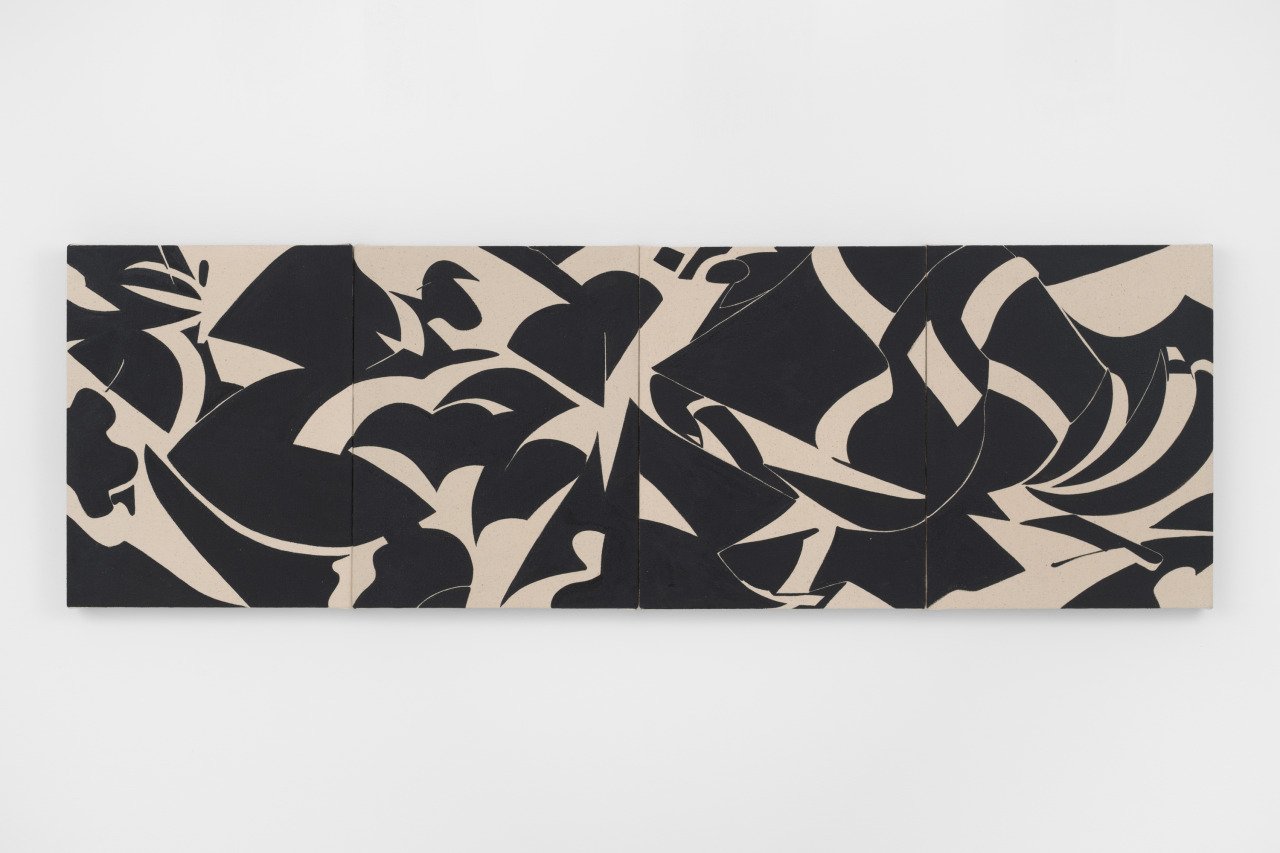Text by Jayne Johnson April 2025
The free-flowing, organic shapes within Kuruneru’s paintings on raw canvas have a rhythmic, almost musical presence. Despite the fact that they look as though they were done by stencil due to their crisp edges, the forms are unplanned and improvised, free hand and free form. The shapes are personal to his body—how far his arms can reach, the movement of his wrist, the control of his hand. The lyrical play between positive and negative space is often at the heart of his paintings—both in the works that incorporate a fine-tuned and nuanced color palette, as well as the monochromatic works in the exhibition, which emphasize the relationship between positive and negative.
Kuruneru’s all-over compositions can find their historical lineage in European and American abstractionists, such as Carla Accardi, Lee Krasner, and Simon Hantai, among others, in which all parts of the canvas are treated with equal importance. Kuruneru creates aqueous solutions of acrylic paint that function almost like watercolor, staining the raw canvas. At times, the colors of adjacent forms bleed into one another in an organic burst, in satisfying contrast to the hard edges of their boundaries—a moment where he must surrender control and let the paint find its own path.
Kuruneru’s interest in incorporating soft washes of tonal color into the paintings is inspired by 20th century artists such as Helen Frankenthaler and Morris Lewis, as well the paint handling found in traditional Chinese mountain landscape paintings—a nod to his own heritage.
Text by Bozidar Brazda 2020
Drawing on the 9th century Chinese “floating perspective” painting philosophy (a kind of multi-perspective precursor to Cubism), Expressionist woodblock prints, and the New York School of Ab-ex, Kuruneru’s newest black-on-raw-canvas works bridge the East-West dichotomy in ways both personal and aesthetic, subtle and literal.
The artist (whose Chinese, Sri Lankan, and Canadian heritage is found referenced throughout his body of painted and drawn works) cites, if only obliquely, the above-mentioned schools, as well as Canada’s Group of Seven landscape painters, as artistic cousins. Ultimately, the resulting works ricochet back and forth between the organic and the carpentered, light and dark, floating and grounded. They exist equally as deconstructed landscapes, super-charged yin yang, and futurist jigsaw puzzles. Their diverse cultural and aesthetic origin-points allow the works to resist easy classification and yet they read instantly as the nuanced, intuitive works of an artist both revisionary and visionary.
The Garden of Forking Paths
Text by Ben Klein 2021
"I leave to the various futures (not to all) my garden of forking paths."
Almost instantly, I understood: "The garden of forking paths" was the chaotic novel; the phrase "the various futures (not to all)" suggested to me the forking in time, not in space.
- Jorge Luis Borges
The artist has produced a new body of his characteristic “Shape” paintings, turning up the color temperature in this iteration of the series, in effect employing a whole new approach to his work through a dramatic shift in palette. Fresh dimensions of space are unearthed by these paintings, which preserve Kuruneru’s powerful use of graphically delineated, irregular forms, splayed across the rectangular surface, in durable but flexible compositions. The visual impact and gestalt of each piece is self-evident the moment the eye settles on its surface, and is then moved along by deft spatial phrasing, as always - but now also animated by controlled chromatic bursts and fields of zinging color.
Kuruneru has a wry, skillful knack for compressing his multivalent influences into outwardly simple, inwardly complex artistic outcomes. At first the “Shape” paintings read like straightforward, beautiful, lyrical abstractions, with a clear family tree in Modernist painting. But they tip the viewer off, slowly but convincingly, that formalism isn’t their only concern, and that no one visual approach can cover their artistic identity. The exhibition title, The Garden of Forking Paths, is taken from a Jorge Luis Borges story, and can be understood as a straightforward descriptor of the paintings - each in itself is a “garden” with many paths, forking and otherwise, running through its pictorial matrix.
But the phrase also locates the conceptual gambit of the work, folding a synchronic approach to time and space that recalls Analytical Cubism and all-over abstraction in with classical Chinese landscape painting, and perhaps even something that approaches a physics or phenomenology of abstract pictorial depiction. Kuruneru isn’t leaning too heavily on the viewer to see all of these things immediately, or to absolutely accept their presence, but just to become aware of their possibility, of the fact that all of these many modes of knowledge have informed the clear and pleasurable painting outcome we confront in each piece.
The artist’s own multicultural and multinational backgrounds have long spurred and suggested to him a starting point within his artistic research, for an investigation into how to simplify and present a wide range of highly diverse and significant origin points. Synthesized into a well-tempered whole in this exhibition, each of these “Forking Paths” presents a different, completed response to this challenge.
